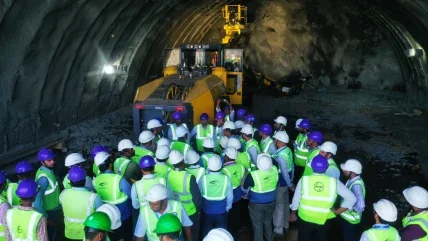
Construction on the undersea tunnel for the Mumbai-Ahmedabad High-Speed Rail (MAHSR) Corridor, also known as the bullet train project, is currently on track.
MAHSR is developed by National High Speed Rail Corporation Limited (NHSRCL), a fully owned subsidiary of Indian Railways, the Ministry of Railways, and the Government of India.
The project is being constructed using Japan’s Shinkansen technology, including rolling stock, signalling and design standards, to support the Make in India programme.
It comprises a 21km undersea tunnel between the bullet train underground station at Mumbai’s Bandra-Kurla Complex and Shilphata in Maharashtra.
Tunnelling works on 16km will be carried out through tunnel boring machines and the remaining 5km using the New Austrian Tunnelling Method (NATM).
It includes a 7km undersea tunnel at Thane Creek, which is said to be India’s first undersea tunnel.
India’s Railway Minister Ashwini Vaishnaw visited the undersea tunnel construction site and expressed his satisfaction with the progress of the project.
Vaishnaw said: “The technology used in the design and construction of the tunnel makes it possible for two trains to pass through at speeds of 250 kilometres per hour.
“In view of that, the engineers have also taken care of the environment with appropriate ventilation and lighting. The construction on 340km of the project has made good progress.
“The stations along the corridor will spur urban development and enhance daily commuters’ productivity by significantly reducing travel time.
“Don’t see the high-speed train as a transportation project, but as integration of the economy. It will elevate India’s infrastructure and economic growth.”
According to NHSRC, construction work has already started at the Additionally Driven Intermediate Tunnel (ADIT) portal, a 394m tunnel already completed in May 2024.
The works also include Shaft 1 at the Mumbai HSR station construction site, Shaft 2 in Vikhroli, Shaft 3 in Savli near Ghansoli, and the Tunnel portal at Shilphata.
MAHSR Corridor, India’s First Bullet Train Project stretches across 508km, providing high-speed connectivity between the Indian states of Maharashtra and Gujarat.
The high-speed bullet train starts from Mumbai’s Bandra Kurla Complex (BKC) area, running at a speed of 320km/h, speeding up intercity travel in the region.
It will have 10 stops between Thane, Virar, Boisar, Vapi, Bilimora, Surat, Bharuch, Vadodara, Anand, and Ahmedabad cities, terminating at Sabarmati.
The bullet train will complete the entire journey within two hours and seven minutes with limited stops at Surat, Vadodara and Ahmedabad.







